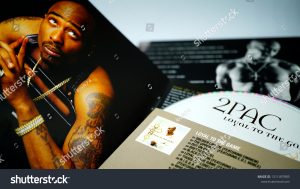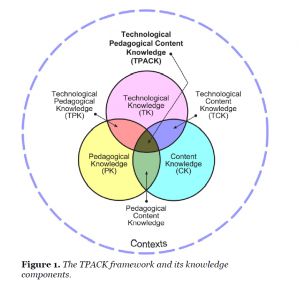

Since I dug my grave supporting Richard
Clark’s view that media offers “no learning
benefits” (1994) in my previous blog, it’s
only natural that I continue to furnish my
new home with more debate-related decor.
This week we have the Substitution, Augmentation, Modification, Redefinition (SAMR) model versus the Technology, Pedagogy, and Content Knowledge (TPACK) model. The former, by Romrell, Kidder, and Wood (2014), sees four different levels of integration of technology into mobile learning. The simplest of which is Substitution, whereby an educator merely replaces the medium of how the content is provided; such as a digital copy instead of print. Next is Augmentation, where some form of functional improvement has been added on. An example they provided was using SMS text message instead of flashcards in reviewing medical information for nursing students (Chuang and Tsao, 2013). Modification seems to be where the activity has been significantly re-designed using technology (Puentedura, 2006), such as learning from interactive computer simulations instead of textbook diagrams. At the apex, we have Redefinition, where technology has allowed for realization of a novel task; like seeing real-time translations with real-time smartphone translations (Liu and Tsai, 2013).
Why did I bother explaining each aspect of the model you ask? Because I have difficulty with the rigidity of four level system and how viewing the same task under a different lens could move it up or down hierarchy. Hamilton, Rosenberg, and Akcaoglu made a similar statement where the SAMR model “dismisses the complexity of teaching with technology by defining and organizing teachers’ uses of technology in predefined ways” (2016). Looking at Liu and Tsai’s study where students were shopping with real-time translations of products the text, I would actually categorize this under Substitution where they could do the same activity by simply going to local foreign-goods store. I also question the purpose of this lesson: how accurate are those product translations (as we’ve heard the horrors Google Translate is capable of), and why would students bother learning English when they can just translate everything the other way into Chinese? Results showing gains in student engagement and learning could be due to the novelty of the experience whereby if this practice becomes ubiquitous, the same indicators would drop as it becomes routine and boring. A personal example I’ll share is my current class project of teaching embroidery. I can use virtual reality (VR) goggles as a Substitution method, or introduce 3-D printing technology / automated sewing machinery as a Redefinition of teaching textiles. At the end of the course, what have students learned and is it transferable? Those students will likely never be able to thread an actual needle in practice. So rather than classify technology into some generic classification, it is more important to understand the content we are trying, the most efficient pedagogical approach, and the capabilities of technology to bring our ideas to fruition. Which brings us to Tupac TPACK.
(I wish I could find a copyright-free image of the event)

At the 2012 Coachella Valley Music and Art Festival, producer Dr. Dre managed to create a ‘hologram’ of deceased rapper Tupac Amaru Shakur. If we apply a liberal amount of cross-discipline analysis, one can view this ‘innovative technology’ as a Redefinition, or at least, Modification of guest performances at concerts. Yet in actuality, this was a Substitution trick where they applied a 19th century theater projection technique to produce a seemingly next-generation technology to engage the audience. So which SAMR model category should this belong to? Here is where I find the Tupac TPACK to a better framework for assessing technology. In the analogy where Dr. Dr is our teacher, he possesses the content knowledge of a music festival (good taste in music?), the pedagogical knowledge (how to make an impact), and the technological knowledge (19th century theatrical tricks), and the ability to combine them all together in order to make an engaging event.
For myself, the TPACK model is a mental checklist in justifying the inclusion or exclusion of activities in my classes. If we re-summon the smartphone translation example and frame it in the context of helping Chinese students learn English, here’s how I would apply TPACK to evaluate the activity:
- Technological knowledge of smartphones and apps that allow for real-time translations – Yes, existing technology and can operate it.
- Pedagogical knowledge that letting students see the local environment in English helps them learn – No, it’s just a novel experience and is actually counterproductive to the necessity of learning English.
- Content knowledge of practical vocabulary list that students will see in stores and the need to learn them – Yes, aware of basic vocabulary they will encounter.
Under TPACK, that activity would fit Technological Content Knowledge, and personally, I would choose to not utilize the smartphone technology because the pedagogical knowledge is undesirable, regardless of how others would brand it as crowning “Redefinition” category under the SAMR model. TPACK also helps me to evaluate my current understanding of the task, in order to select an appropriate technology (or what Clark calls media). Let’s say the context is myself teaching biomolecules (proteins, carbs, fats) in Biology 12, here is sample evaluation before I decide on the design:
- Content Knowledge – familiarity with content competencies under the Biology 12 curriculum.
- Pedagogical Knowledge – practices to provide meaningful engagement to the targeted class.
- Technological Knowledge – list of available tools & my ability to operate them.
A tried-and-true method to teach this would be printing pages of notes and having students memorize 2D structures of biomolecules. This covers the content knowledge and uses simple technology to accomplish, but the lack of pedagogical knowledge of inefficient student learning using this approach. Switching the technology to utilize digital instead of print may make it more accessible, but does not address the issue of pedagogy. Thus, I need to re-evaluate that piece and perhaps teach using physical, interactive models whereby students experience hands-on construction and manipulation of pieces (repeatedly) to internalize the structure of say, fatty acids. The content remains the same while the pedagogy has improved, which leaves me the freedom of selecting an appropriate technology. In a face-to-face classroom, I would opt for traditional ball & stick models as it’s my belief that tactile sensations help improve learning; but I would choose digital simulations for those who are in an online classroom. These decisions are made based on reflecting on all three fields of knowledge, hence I am able to justify my choice of ordering more marshmallows and skewers instead of just doing everything digitally.